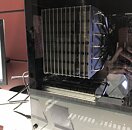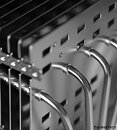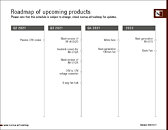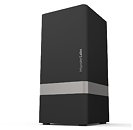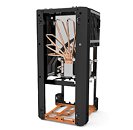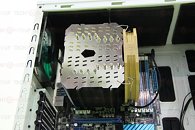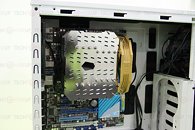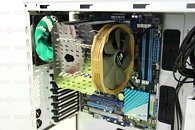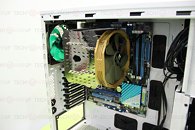Streacom and CALYOS Demonstrate the Fanless SG10 Chassis
The time has finally come for Streacom to reveal the fruits of their collaborative labor with CALYOS in creating the SG10 fanless chassis. Though originally based on the NSG S0 (or NSG0), the entire project has undergone a complete redesign over the last few years to deliver the SG10 being shown off at Computex 2023. The new design is a 15 kg metal and glass monster featuring two of CALYOS' specially designed "Loop Heat Pipe" evaporation cooling systems that pull heat from the CPU and GPU, then passively radiate that heat away via two large condensers at the top of the chassis. The main body of the chassis is assembled from steel and extruded aluminium, and features tempered glass side panels. The front, rear, top, and bottom are all open to allow air to move through the chassis. The interior of the chassis uses a dynamic rail system, similar to Streacom's other case designs such as the DA2 and DB4, where adjustable brackets mount to structural rails running along the top and bottom of the chassis. The main components, such as an ATX motherboard and the GPU, are to be mounted to these rails in an X configuration on opposite sides of the chassis, facing each of the glass panels, while the power supply mounts to the floor of the chassis behind the motherboard. For drive support the chassis features an array of extra brackets with slots for screws to affix five 3.5" or 2.5" drives to. The front and optional rear I/O plates mount to the vertical steel structures and can be placed anywhere on those sides.
Streacom had a demo at their booth with the SG10 cooling a Core i9-13900K and GeForce RTX 4080 under a FurMark load with a total system power draw of around 680 W. While the RTX 4080 was sitting at a quite comfortable 75° C, the i9-13900K was stuck right up against its thermal limit of 100° C. Streacom claims the CPU and GPU loops of the cooler utilize identical designs with the only difference being the mounting bracket, however due to the GPU block being mounted directly to the GPU die the cooling is rated at 350 W rather than 250 W. They claim if the CPU loop is mounted direct-die it would perform similarly to the GPU loop, and it's possible to add 120 mm fans along the top, below the condensers, to further improve cooling. Another complication—not unlike with custom water cooling parts—is the GPU side of the cooler requires that mounting brackets and VRM/VRAM heatsinks be made to fit specific generations of cards. As such Streacom only advertises compatibility with the most recent generations of GeForce RTX 3000 and 4000 series, as well as Radeon RX 6000 and 7000, and only those which have a PCB shorter than 280 mm, but support is expected to improve with new bracket kits available after launch. The pricing has yet to be confirmed for the SG10 but it's rumored that it will land around the $1000 USD price point when it launches.
Streacom had a demo at their booth with the SG10 cooling a Core i9-13900K and GeForce RTX 4080 under a FurMark load with a total system power draw of around 680 W. While the RTX 4080 was sitting at a quite comfortable 75° C, the i9-13900K was stuck right up against its thermal limit of 100° C. Streacom claims the CPU and GPU loops of the cooler utilize identical designs with the only difference being the mounting bracket, however due to the GPU block being mounted directly to the GPU die the cooling is rated at 350 W rather than 250 W. They claim if the CPU loop is mounted direct-die it would perform similarly to the GPU loop, and it's possible to add 120 mm fans along the top, below the condensers, to further improve cooling. Another complication—not unlike with custom water cooling parts—is the GPU side of the cooler requires that mounting brackets and VRM/VRAM heatsinks be made to fit specific generations of cards. As such Streacom only advertises compatibility with the most recent generations of GeForce RTX 3000 and 4000 series, as well as Radeon RX 6000 and 7000, and only those which have a PCB shorter than 280 mm, but support is expected to improve with new bracket kits available after launch. The pricing has yet to be confirmed for the SG10 but it's rumored that it will land around the $1000 USD price point when it launches.







